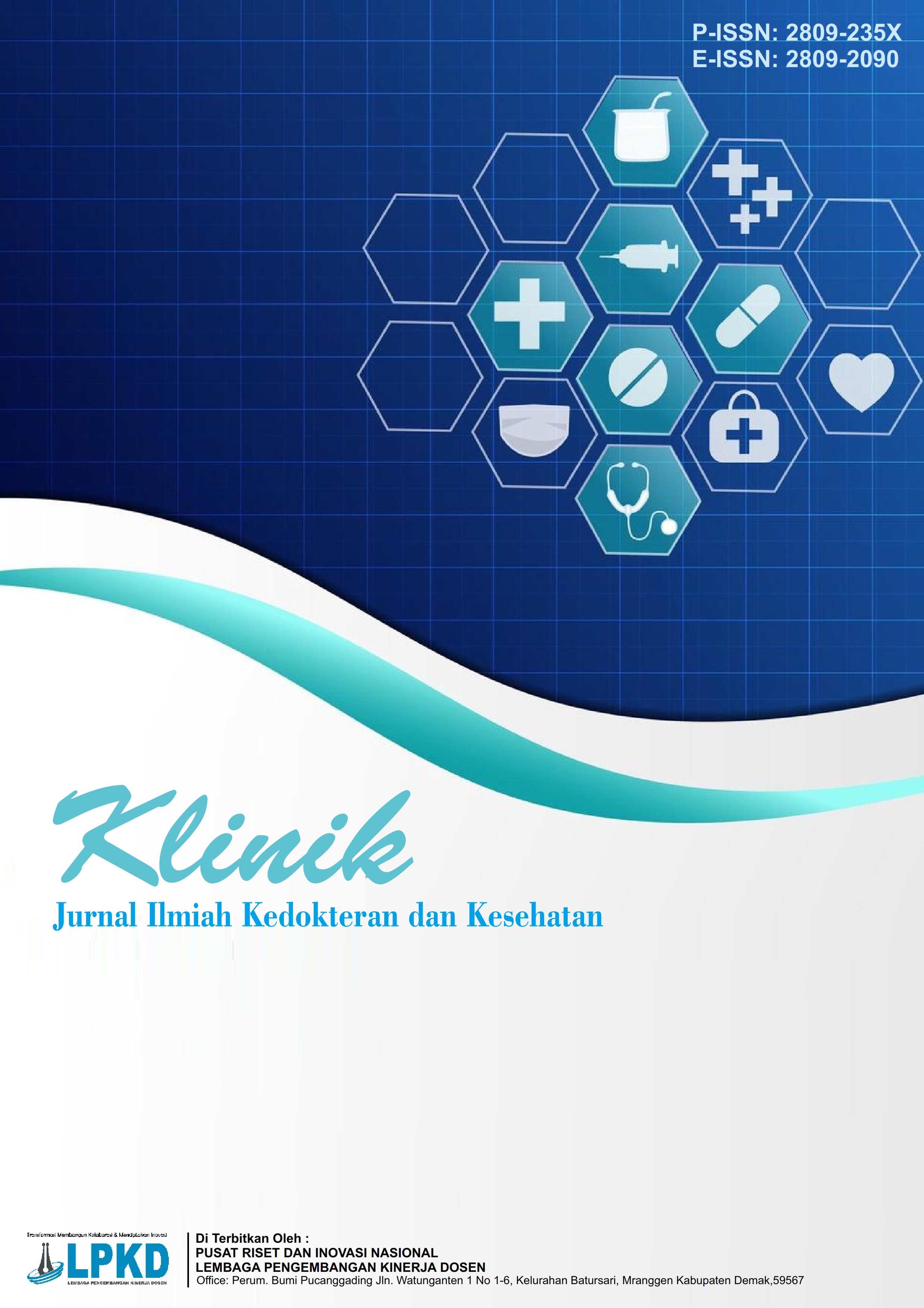Hubungan Status Gizi dengan Tumbuh Kembang pada Anak Usia 2-5 Tahun di Wilayah Kerja Puskesmas Limapuluh Kota Pekanbaru
DOI:
https://doi.org/10.55606/klinik.v5i1.5685Keywords:
Nutritional status, Child growth and development, Toddler, Stunting, Fifty Health CenterAbstract
Background The growth and development phase of children aged 2–5 years is crucial as it determines their future physical, mental, and behavioral outcomes. Wasting, stunting, and underweight remain major nutritional problems among young children, significantly affecting their development. In Pekanbaru City, particularly at Limapuluh Public Health Center, the prevalence of stunting is 5.16%, wasting 11.94%, and underweight 17.1%. These conditions highlight the importance of studying the relationship between nutritional status and child development in this critical age group.Objective To determine the relationship between nutritional status and development in children aged 2–5 years at Limapuluh Public Health Center, Pekanbaru.Methods This study employed an analytical observational design with a cross-sectional approach. The research was conducted at Limapuluh Public Health Center, Pekanbaru. Samples were obtained using accidental sampling, with primary data collected according to inclusion criteria. Data were analyzed using Spearman’s rank correlation test.Result : Among 88 children aged 2–5 years, most had normal nutritional status (75.0%) and normal development (87.5%). Spearman’s test revealed a strong positive correlation between nutritional status and child development (r = 0.682; p < 0.001).Conclusion There is a strong and significant positive relationship between nutritional status and development in children aged 2–5 years; the better the nutritional status, the more optimal the child’s development.
References
Ayukarningsih, Y., Mutiara, D., & Febrianti, A. (2023). The relationship between nutritional status and development of children age 0–24 months at Cimahi Selatan Health Center. Journal of Health and Dental Sciences, 3(2), 183–196. https://doi.org/10.54052/jhds.v3n2.p183.196
Hafni Sahir, S. (2022). Metodologi penelitian. www.penerbitbukumurah.com
Hamsir Saleh, M., Faisal, M., & Rachmat Irwan, M. (2019). Klasifikasi status gizi balita menggunakan metode K-nearest neighbor.
Ho, F. K., Rao, N., Tung, K. T. S., Wong, R. S., Wong, W. H. S., Tung, J. Y. L., Chua, G. T., Tso, W. W. Y., Bacon-Shone, J., Wong, I. C. K., Yousafzai, A., Wright, C., & Ip, P. (2021). Association of early nutritional status with child development in the Asia Pacific region. JAMA Network Open, 4(12), 1–12. https://doi.org/10.1001/jamanetworkopen.2021.39543
Hulu, V. T., Manalu, P., Ripta, F., Sijabat, V. H. L., Hutajulu, P. M. M., & Sinaga, E. A. (2022). Tinjauan naratif: Faktor-faktor yang berhubungan dengan status gizi anak balita. AcTion: Aceh Nutrition Journal, 7(2), 250. https://doi.org/10.30867/action.v7i2.632
Kadhim, B. M. (2024). Prevalence of obesity in preschool children at Hilla/Babylon/Iraq 2020. Mustansiriya Medical Journal, 23(2), 101–101. https://doi.org/10.4103/mj.mj_22_24
Kementerian Kesehatan Republik Indonesia. (2020). Peraturan Menteri Kesehatan Republik Indonesia Nomor 2 Tahun 2020 tentang Standar Antropometri Anak (pp. 1–78).
Metwally, A. M., Abdallah, A. M., El-Din, E. M. S., Zeid, D. A., Khadr, Z., Elshaarawy, G. A., Elkhatib, A. A., Elsaied, A., Ashaat, E. A., Elghareeb, N. A., Abdou, M. H., Fathy, A. M., Eldeeb, S. E., AbdAllah, M., Soliman, M. A. T., El Banna, R. A. E. S., Hassanein, A. K., Rabah, T. M., Abdelrahman, M., & Sallam, S. F. (2023). Screening and determinant of suspected developmental delays among Egyptian preschool-aged children: A cross-sectional national community-based study. BMC Pediatrics, 23(1), 1–18. https://doi.org/10.1186/s12887-023-04335-0
Papotot, G. S., Rompies, R., & Salendu, P. M. (2021). Pengaruh kekurangan nutrisi terhadap perkembangan sistem saraf anak. Jurnal Biomedik (JBM), 13(3), 266. https://doi.org/10.35790/jbm.13.3.2021.31830
Paramita, I. S., Atasasih, H., & Rahayu, D. (2024a). Penilaian status gizi antropometri pada balita. Penerbit Salnesia (CV. Sarana Ilmu Indonesia).
Paramita, I. S., Atasasih, H., & Rahayu, D. (2024b). Penilaian status gizi antropometri pada balita. Penerbit Salnesia (CV. Sarana Ilmu Indonesia).
Patel, K. K., Vijay, J., & Saroja, A. B. (2024). Gender and dietary diversity among children aged 6–24 months – Evidence from a nationally representative survey. Journal of Health, Population and Nutrition, 43(1). https://doi.org/10.1186/s41043-024-00716-y
Pradono. (2018). Panduan manajemen penelitian kuantitatif.
Pratama, A. A., Ardian, J., Lastyana, W., Jauhari, M. T., & Fitria, B. (2023). Hubungan status gizi dengan perkembangan anak usia 1–5 tahun. Relationship Between Nutritional Status and Child Development Ages 1–5 Years.
Rahayu, N., dkk. (2020). Profil kesehatan Provinsi Riau tahun 2020.
Sihotang, W. Y., Hulu, V. T., Samosir, F. J., Pane, P. Y., Hartono, H., Manalu, P., Siagian, M., & Panjaitan, H. I. L. (2023). Determinants of stunting in children under five: A scoping review. Jurnal Gizi Indonesia (The Indonesian Journal of Nutrition), 12(1), 9–20. https://doi.org/10.14710/jgi.12.1.9-20
Victor, A. (2023). Dietary pattern, biochemical, and anthropometric indices of preschool children age 2–5 years in Ogugu Olamaboro Local Government of Kogi State. Obesity and Weight Loss, 5(1), 1–12. https://doi.org/10.24966/owl-7372/100011
Were, J. M., Stranges, S., Sharma, I., Vargas-Gonzalez, J. C., & Campbell, M. K. (2021). Examining the double burden of malnutrition for preschool children and women of reproductive age in low-income and middle-income countries: A scoping review protocol. BMJ Open, 11(12), 1–5. https://doi.org/10.1136/bmjopen-2021-054673
Wondmagegn, T., Girma, B., & Habtemariam, Y. (2024). Prevalence and determinants of developmental delay among children in low- and middle-income countries: A systematic review and meta-analysis. Frontiers in Public Health, 12(April), 1–10. https://doi.org/10.3389/fpubh.2024.1301524
Wulandari, A. A., Mokhtar, S., Nurmadilla, D. N., Bamahry, A. B., & Jafar, A. (2023). Hubungan antara status gizi dengan prestasi belajar anak pada usia 9–12 tahun. Hospital Journal, 4(1).
Downloads
Published
How to Cite
Issue
Section
License
Copyright (c) 2025 Jurnal Ilmiah Kedokteran dan Kesehatan

This work is licensed under a Creative Commons Attribution-ShareAlike 4.0 International License.








